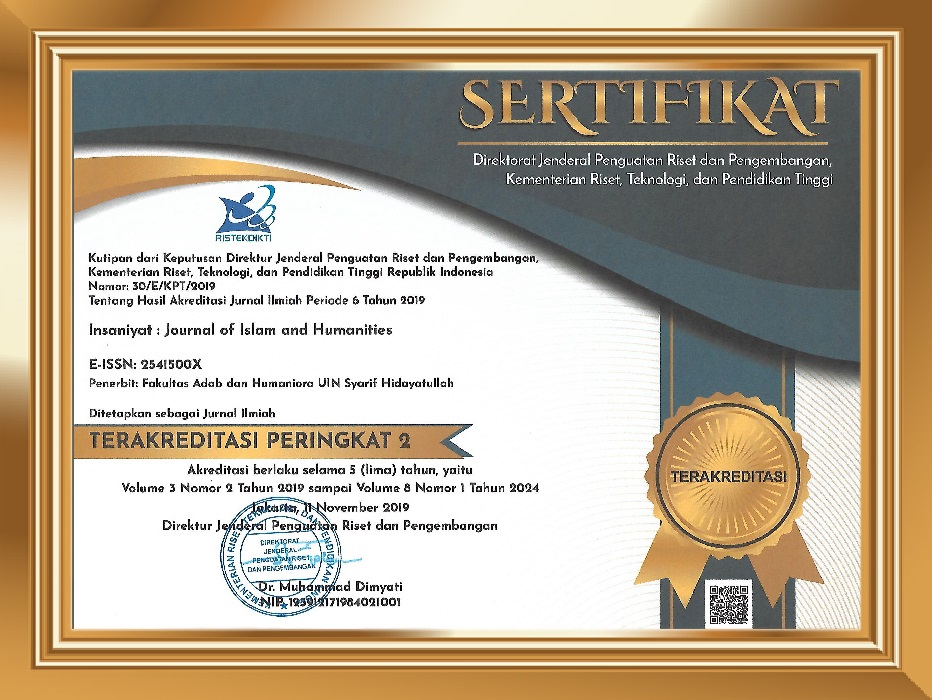The Meanings of Publication in Open Access Journal: Experience of State Islamic University's Lecturers
Abstract
The Indonesian Ministry of Research, Technology, and Higher Education always encourages lecturers to publish their scientific works in open access publications. This study explores the meaning of open access publications from the experiences of UIN lecturers. This study uses a qualitative method with a phenomenological approach to identify the interpretation and meaning of lecturers on open access journal publications. This study found that lecturers know about publishing in open access journals and their advantages. They choose reputable journals in their scientific field as their first reference because the journals that fall into this category have a high level of readability and citation. However, the informants stated that they were also pragmatic; they will reconsider the decision to publish in a reputable and open access journal if the publication fee is deemed too expensive. This study uses Hall's meanings concept, whose application is not only to explore the views of lecturers on open access publications but also to explore the actions they take so that their writings can be included in open access publications. Here, the researcher finds the emerging theme that is the importance of collaboration. It is as a way to overcome barriers to open access publishing and also as the key to the productivity of writing articles in academic journals. This study highlights several important themes related to collaboration. The integration of Islamic knowledge with scientific disciplines is an interesting issue when discussing the benefits of cooperation. The results of this study can provide insight into the meaning of open access journals published by lecturers and how they overcome the barriers in this matter. The researcher suggests using a quantitative approach based on our data for future research.
Keywords
References
Bartling, S., & Friesike, S. (Eds.). (2014). Opening Science: The Evolving Guide on How the Internet is Changing Research, Collaboration and Scholarly Publishing (1st ed. 2014). Cham: Springer International Publishing : Imprint: Springer. https://doi.org/10.1007/978-3-319-00026-8
Bozeman, B., Fay, D., & Slade, C. P. (2013). Research collaboration in universities and academic entrepreneurship: The-state-of-the-art. The Journal of Technology Transfer, 38(1), 1–67. https://doi.org/10.1007/s10961-012-9281-8
Green, B. N., & Johnson, C. D. (2015). Interprofessional collaboration in research, education, and clinical practice: Working together for a better future. The Journal of Chiropractic Education, 29(1), 1–10. https://doi.org/10.7899/JCE-14-36
Hall, S. (1997). Representation: Cultural Representations and Signifying Practices. London ; Thousand Oaks, Calif: SAGE Publications, Inc.
Kamerlin, S. C. L., Allen, D. J., Bruin, B., Derat, E., & Urdal, H. (2021). Journal Open Access and Plan S: Solving Problems or Shifting Burdens? Development and Change, 52(3), 627–650. https://doi.org/10.1111/dech.12635
Lukman, Ekawati Marlina, Ratih Keumalasari, Siagian, A. H. A. M., & Slamet Riyanto. (2012). Perkembangan Open Access Jurnal Ilmiah Indonesia. https://doi.org/10.13140/2.1.1159.2009
Martin, S. J. (2020). The FEBS Journal in 2020: Open Access and quality versus quantity publishing. The FEBS Journal, 287(1), 4–10. https://doi.org/10.1111/febs.15191
Masrek, M. N., & Yaakub, M. S. (2015). Intention to Publish in Open Access Journal: The Case of Multimedia University Malaysia. Procedia - Social and Behavioral Sciences, 174, 3420–3427. https://doi.org/10.1016/j.sbspro.2015.01.1013
Moore, S. A. (2020). Revisiting “the 1990s debutante”: Scholar‐led publishing and the prehistory of the open access movement. Journal of the Association for Information Science and Technology, 71(7), 856–866. https://doi.org/10.1002/asi.24306
Nariani, R., & Fernandez, L. (2012). Open Access Publishing: What Authors Want. College & Research Libraries, 73(2), 182–195. https://doi.org/10.5860/crl-203
Nicholas, D., Jamali, H. R., Herman, E., Xu, J., Boukacem-Zeghmouri, C., Watkinson, A., … Polezhaeva, T. (2020). How is open access publishing going down with early career researchers? An international, multi-disciplinary study. El Profesional de La Información, e290614. https://doi.org/10.3145/epi.2020.nov.14
Picarra, M. (2015). Monitoring Compliance with Open Access policies. PASTEUR4OA, 1–15.
Pinfield, S., Wakeling, S., Bawden, D., & Robinson, L. (2020). Open Access In Theory And Practice: The Theory-Practice Relationship And Openness.
Solomon, D. J. (2014). A survey of authors publishing in four megajournals. PeerJ. https://doi.org/10.7717/peerj.365
Suber, P. (2012). Open Access. Cambridge: MIT Press.
van den Besselaar, P. (2019). Interdisciplinary and disciplinary identities: Towards a theory of forms of knowledge change [Preprint]. Scientific Communication and Education. https://doi.org/10.1101/603449
Wine, O., Ambrose, S., Campbell, S., Villeneuve, P. J., Burns, K. K., & Vargas, A. O. (2017). Key Components of Collaborative Research in the Context of Environmental Health: A Scoping Review. Journal of Research Practice, 13(2), 32.
Wismanto, Hitami, M., & Anwar, A. (2021). “INTEGRASI ISLAM DAN SAINS DALAM PENGEMBANGAN KURIKULUM DI UIN (Evaluasi Penerapan Integrasi Islam dan Sains di UIN dalam Kurikulum dan Proses Pembelajaran).” JURNAL RANDAI, 2(1), 85–94. https://doi.org/10.31258/randai.2.1.p.85-94
DOI: 10.15408/insaniyat.v6i2.25462
Refbacks
- There are currently no refbacks.






